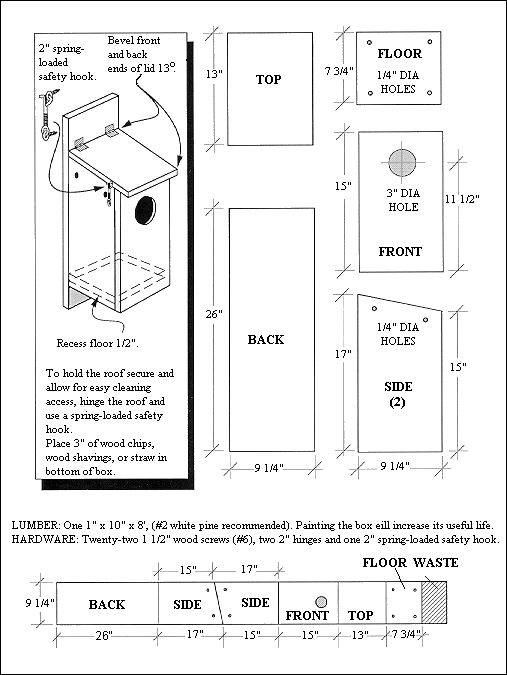Kestrel Nest Box Plan - Maryland's Wild Acres
Main_Content

How to Build a Kestrel Box
Materials:
One 1" x 10" x 8' board
Two hinges
1 ½" galvanized nails
Wire
Construction:
- Mark and cut out the pieces as shown.
- Cut a 3" diameter entrance hole in the front piece, 11 ½" from the bottom edge.
- Drill two ¼" holes near the top edge of both side pieces. Drill four ¼" holes in the floor piece, as shown, to allow for drainage.
- Assemble the box as shown in the diagram.
- Attach the roof on top of the box using two hinges, for easy cleaning access.
- Place one nail in the side of the roof and one nail in the face of the adjoining side piece, as shown in the diagram, so that they line up vertically. Use wire tied around the two nails to keep the roof closed to predators.
- Place 2-3" of wood shavings on the bottom of the box.
Kestrel Nest Box Tips
Kestrel boxes have been shown to seriously increase the number of nesting kestrel pairs in an area. Here are some suggestions:
- Nest boxes should be placed in open fields, meadows or along hedgerows next to open areas. A grassy habitat should be near the box so kestrels can use it for hunting.
- Kestrel nest boxes should be firmly attached to a support structure, such as a tree or post, 10 to 30 feet above the ground and spaced at least half a mile apart.
- The support structure should have a sheet of aluminum secured around it to prevent squirrels from climbing and using the box.
- Place 2 to 3 inches of sawdust in the bottom of the nest box.
- Boxes should be installed no later than February 1st, to allow kestrels to find nest sites when first returning north.
- Since starlings may use the box, check the box once a week and remove the nest and eggs of any starlings present. Starlings are unprotected by law and thus you are permitted to do this. Starling eggs are white with a blue-green tint, but other species such as bluebirds (bright blue eggs) and tree swallows (white eggs) may also use the nest box. Be sure you can identify the eggs, but when in doubt, wait for one of the parents to return for positive identification.
- Clean out the kestrel box after each nesting season and replace the wood shavings for next season's nesting pair.
Design
Courtesy of Minnesota DNR
Illustration Courtesy of the
USGS,
Northern Prairie Wildlife Research Center
Return
to Wild Acres - American Kestrel